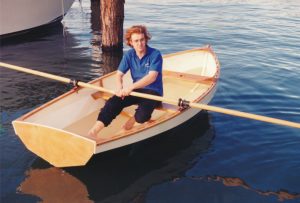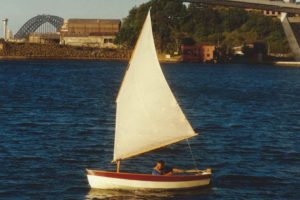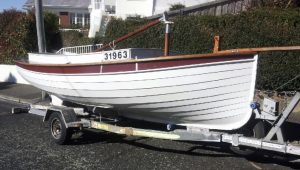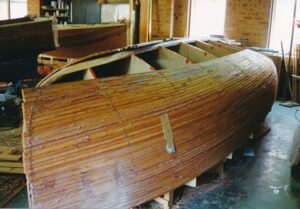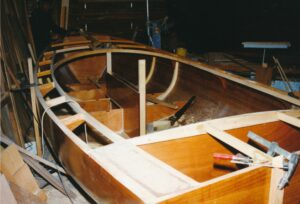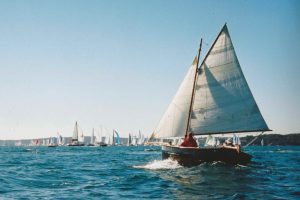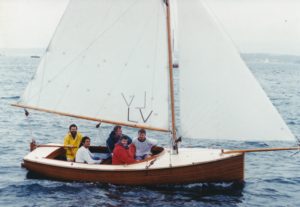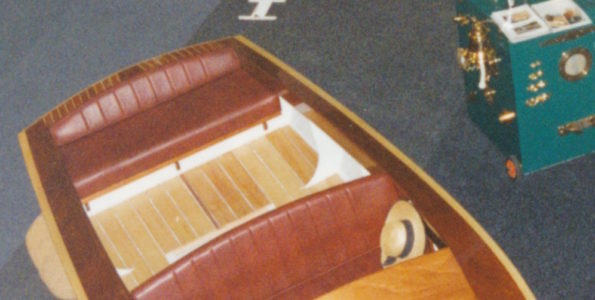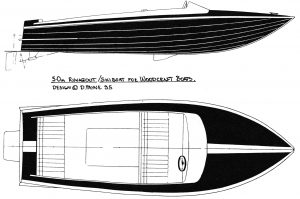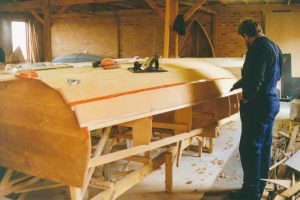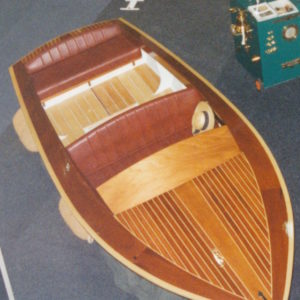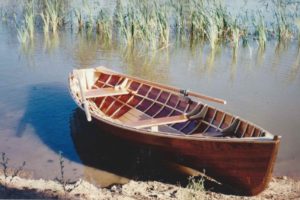 Bill Fisher of Drummoyne then Putney, from the famous Sydney boatbuilding family, built the original of this boat in his retirement for his own use in 1947. He built it like the Watermen’s skiffs that were common before the turn of the 20th Century when he began to learn his trade. Ian Smith took the lines off Eva Seabird in 1992, and quite a few boats have been built to this design since. It can be built traditionally clinker planked, or with glued plywood clinker construction or strip-planked. This boat pictured was built by Brendan McMurdo.
Bill Fisher of Drummoyne then Putney, from the famous Sydney boatbuilding family, built the original of this boat in his retirement for his own use in 1947. He built it like the Watermen’s skiffs that were common before the turn of the 20th Century when he began to learn his trade. Ian Smith took the lines off Eva Seabird in 1992, and quite a few boats have been built to this design since. It can be built traditionally clinker planked, or with glued plywood clinker construction or strip-planked. This boat pictured was built by Brendan McMurdo.
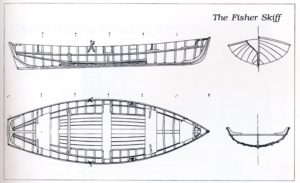
There is a separate construction plan for traditional clinker construction, and another sheet shows details for ply clinker and strip planking. Beam is 1.35m (4’5″). Eight-foot oars are about right.
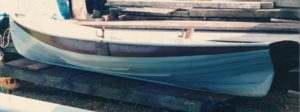 This is the original boat, known as the Eva Seabird. The family story goes that Bill Fisher wanted to call it Seabird but his sister Eva wanted it named after her, so it became Eva Seabird. In the 1950’s Bill , at the time in his 80’s, raced another veteran Tom Hall from Palm Beach to Manly (about 18 nautical miles, offshore) and won in a strong offshore Westerly. The builder’s great-grandson was working for me in 1992 at River Quays Marina opposite the Fisher shed in Putney, and Stuart rowed the boat to work. I asked his grandfather, the oldest family member still alive at that point if I could take off the lines, which he was happy to agree to.
This is the original boat, known as the Eva Seabird. The family story goes that Bill Fisher wanted to call it Seabird but his sister Eva wanted it named after her, so it became Eva Seabird. In the 1950’s Bill , at the time in his 80’s, raced another veteran Tom Hall from Palm Beach to Manly (about 18 nautical miles, offshore) and won in a strong offshore Westerly. The builder’s great-grandson was working for me in 1992 at River Quays Marina opposite the Fisher shed in Putney, and Stuart rowed the boat to work. I asked his grandfather, the oldest family member still alive at that point if I could take off the lines, which he was happy to agree to.
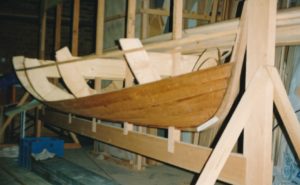 The first one we built was built at various shows in 1993. When our shed moved to Glebe Point we kept the boat in davits and often rowed it all around Sydney Harbour. This style of clinker boat is built upright when planked traditionally. The ply clinker and strip-planked versions are easier built upside-down.
The first one we built was built at various shows in 1993. When our shed moved to Glebe Point we kept the boat in davits and often rowed it all around Sydney Harbour. This style of clinker boat is built upright when planked traditionally. The ply clinker and strip-planked versions are easier built upside-down.
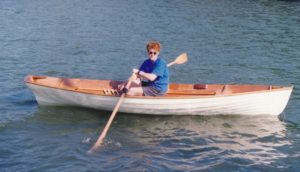 A ply clinker version was next, built in a Summer School class, and proved to be an excellent rowing boat like the traditional one, being lighter it was marginally faster, except against a headwind. The plans come with full-size patterns for the moulds as well as the stem and stern knees and transom.
A ply clinker version was next, built in a Summer School class, and proved to be an excellent rowing boat like the traditional one, being lighter it was marginally faster, except against a headwind. The plans come with full-size patterns for the moulds as well as the stem and stern knees and transom.
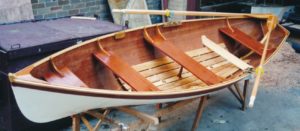 The first strip-planked version was next, also built in a class. This one also had a pair of custom 9’oars on fold-out rowlocks as requested by the customer who eventually bought it.
The first strip-planked version was next, also built in a class. This one also had a pair of custom 9’oars on fold-out rowlocks as requested by the customer who eventually bought it.
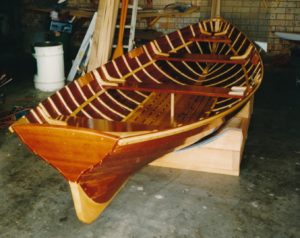 Several others have been built, including this beautiful traditional version by Allan Cumner in Bundaberg Queensland.
Several others have been built, including this beautiful traditional version by Allan Cumner in Bundaberg Queensland.



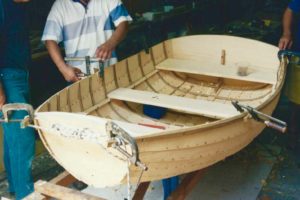 Pee Wee is an ideal yacht tender at 2.1m (6’8″)and can be built with traditional clinker planking, plywood clinker planking or strip planking. The original Pee Wee was designed by Ian Smith to be the tender to his canoe yawl Tirrick in the 1980’s and was strip-planked and sheathed with glass cloth set in WEST System Epoxy resin. It was such a stable little dinghy that Ian drew up a traditional clinker construction plan and it became the subject of the majority of the Sydney Wooden Boat School’s Traditional Clinker classes in the 1990’s, some planked in Huon Pine and some in Australian Red Cedar, and one in White Beech. The Traditional Clinker manual, also available, focuses on the building of her bigger sister Petrel, a very similar boat.
Pee Wee is an ideal yacht tender at 2.1m (6’8″)and can be built with traditional clinker planking, plywood clinker planking or strip planking. The original Pee Wee was designed by Ian Smith to be the tender to his canoe yawl Tirrick in the 1980’s and was strip-planked and sheathed with glass cloth set in WEST System Epoxy resin. It was such a stable little dinghy that Ian drew up a traditional clinker construction plan and it became the subject of the majority of the Sydney Wooden Boat School’s Traditional Clinker classes in the 1990’s, some planked in Huon Pine and some in Australian Red Cedar, and one in White Beech. The Traditional Clinker manual, also available, focuses on the building of her bigger sister Petrel, a very similar boat.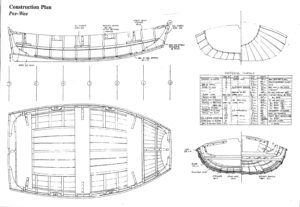 The Traditional Clinker construction plan contains the fastening list as well. The plans contain full size patterns for the moulds and for the bow and stern transoms, so no lofting is necessary. Details for ply clinker and strip-planked construction are also included.
The Traditional Clinker construction plan contains the fastening list as well. The plans contain full size patterns for the moulds and for the bow and stern transoms, so no lofting is necessary. Details for ply clinker and strip-planked construction are also included.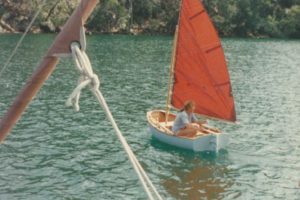 The original Pee Wee was strip-planked and had an unstayed gunter rig, but the centreboard case just forward of the main thwart meant that the rower would often get a wet bum.
The original Pee Wee was strip-planked and had an unstayed gunter rig, but the centreboard case just forward of the main thwart meant that the rower would often get a wet bum.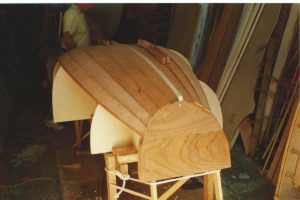
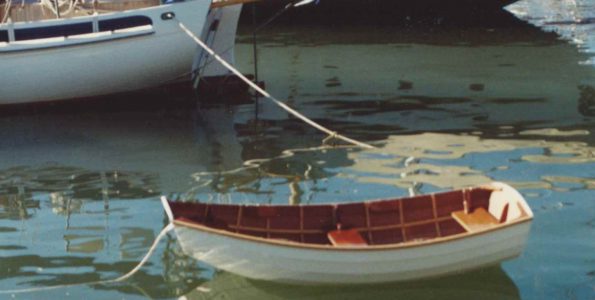
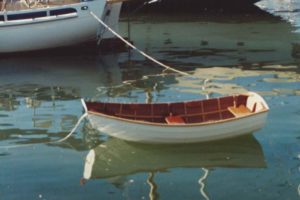
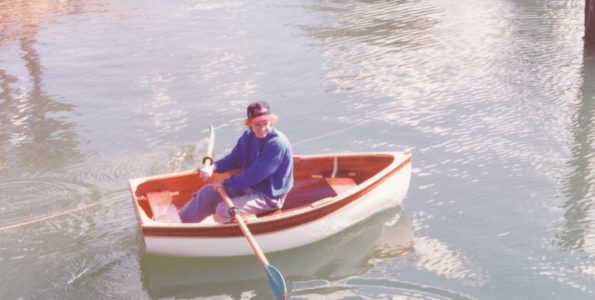
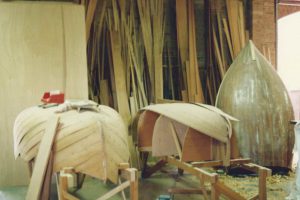
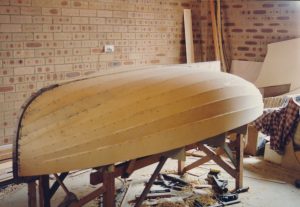
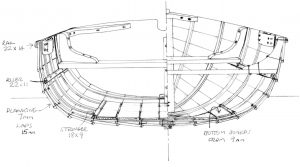
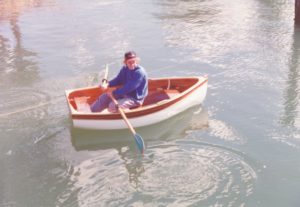
 Bill Fisher of Drummoyne then Putney, from the famous Sydney boatbuilding family, built the original of this boat in his retirement for his own use in 1947. He built it like the Watermen’s skiffs that were common before the turn of the 20th Century when he began to learn his trade. Ian Smith took the lines off Eva Seabird in 1992, and quite a few boats have been built to this design since. It can be built traditionally clinker planked, or with glued plywood clinker construction or strip-planked. This boat pictured was built by Brendan McMurdo.
Bill Fisher of Drummoyne then Putney, from the famous Sydney boatbuilding family, built the original of this boat in his retirement for his own use in 1947. He built it like the Watermen’s skiffs that were common before the turn of the 20th Century when he began to learn his trade. Ian Smith took the lines off Eva Seabird in 1992, and quite a few boats have been built to this design since. It can be built traditionally clinker planked, or with glued plywood clinker construction or strip-planked. This boat pictured was built by Brendan McMurdo.
 This is the original boat, known as the Eva Seabird. The family story goes that Bill Fisher wanted to call it Seabird but his sister Eva wanted it named after her, so it became Eva Seabird. In the 1950’s Bill , at the time in his 80’s, raced another veteran Tom Hall from Palm Beach to Manly (about 18 nautical miles, offshore) and won in a strong offshore Westerly. The builder’s great-grandson was working for me in 1992 at River Quays Marina opposite the Fisher shed in Putney, and Stuart rowed the boat to work. I asked his grandfather, the oldest family member still alive at that point if I could take off the lines, which he was happy to agree to.
This is the original boat, known as the Eva Seabird. The family story goes that Bill Fisher wanted to call it Seabird but his sister Eva wanted it named after her, so it became Eva Seabird. In the 1950’s Bill , at the time in his 80’s, raced another veteran Tom Hall from Palm Beach to Manly (about 18 nautical miles, offshore) and won in a strong offshore Westerly. The builder’s great-grandson was working for me in 1992 at River Quays Marina opposite the Fisher shed in Putney, and Stuart rowed the boat to work. I asked his grandfather, the oldest family member still alive at that point if I could take off the lines, which he was happy to agree to. The first one we built was built at various shows in 1993. When our shed moved to Glebe Point we kept the boat in davits and often rowed it all around Sydney Harbour. This style of clinker boat is built upright when planked traditionally. The ply clinker and strip-planked versions are easier built upside-down.
The first one we built was built at various shows in 1993. When our shed moved to Glebe Point we kept the boat in davits and often rowed it all around Sydney Harbour. This style of clinker boat is built upright when planked traditionally. The ply clinker and strip-planked versions are easier built upside-down. A ply clinker version was next, built in a Summer School class, and proved to be an excellent rowing boat like the traditional one, being lighter it was marginally faster, except against a headwind. The plans come with full-size patterns for the moulds as well as the stem and stern knees and transom.
A ply clinker version was next, built in a Summer School class, and proved to be an excellent rowing boat like the traditional one, being lighter it was marginally faster, except against a headwind. The plans come with full-size patterns for the moulds as well as the stem and stern knees and transom. The first strip-planked version was next, also built in a class. This one also had a pair of custom 9’oars on fold-out rowlocks as requested by the customer who eventually bought it.
The first strip-planked version was next, also built in a class. This one also had a pair of custom 9’oars on fold-out rowlocks as requested by the customer who eventually bought it. Several others have been built, including this beautiful traditional version by Allan Cumner in Bundaberg Queensland.
Several others have been built, including this beautiful traditional version by Allan Cumner in Bundaberg Queensland.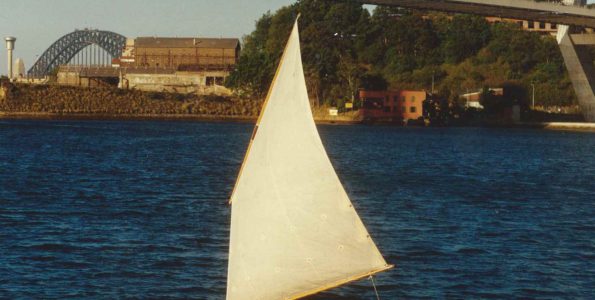
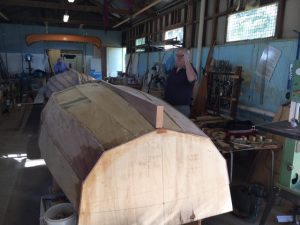 At the School in the early 1990’s we needed a boat that would be a good introduction to a number of boatbuilding techniques but be simple enough for a class to structurally complete in two busy weekends. I drew up the Whiting Skiff to be pretty much a maximum size for car-topping. The lucky result was that it is not only a good boat for learning techniques, it is a terrific boat in the water.
At the School in the early 1990’s we needed a boat that would be a good introduction to a number of boatbuilding techniques but be simple enough for a class to structurally complete in two busy weekends. I drew up the Whiting Skiff to be pretty much a maximum size for car-topping. The lucky result was that it is not only a good boat for learning techniques, it is a terrific boat in the water. 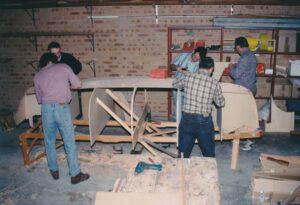 It can be rowed or sailed or even motored with a small outboard.
It can be rowed or sailed or even motored with a small outboard.